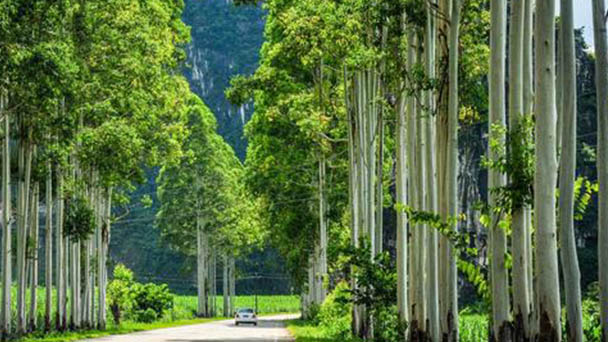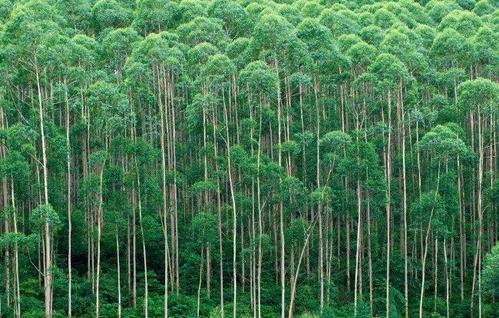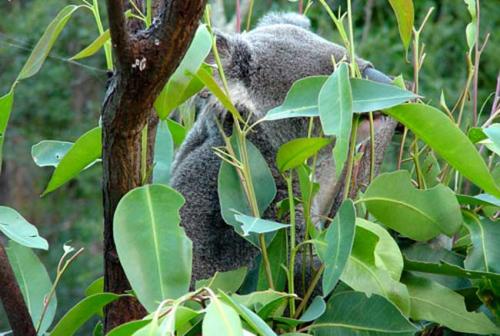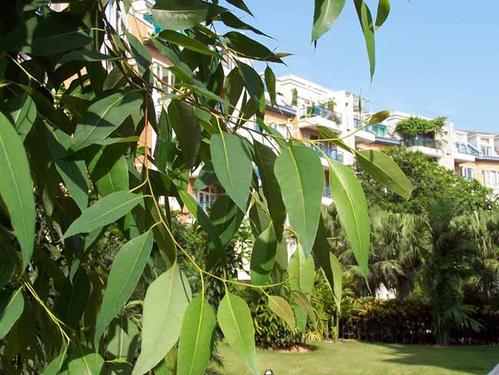Swamp Mahogany (Eucalyptus Robusta) profile
Written by admin
Aug 30 2021

Swamp Mahogany (Eucalyptus robusta Smith), also called swamp messmate, is a Swamp tree in the Myrtle and Eucalyptus genus. Swamp Mahogany is an evergreen tall trees, about 600 species. Swamp Mahogany is an evergreen plant, a year with periodic phenomenon of dead leaves off, most varieties are tall trees, a few are small trees, and a shrubby very few. The shape of the tree crown is steeple, multi - branched and vertical branches. Leaves are simple, entire, leathery, sometimes covered with a thin waxy layer. Leaves of Swamp Mahogany can be divided into juvenile leaves, intermediate leaves and mature leaves, most varieties of opposite leaves, small, heart-shaped or broadly lanceolate. Swamp Mahogany was introduced to all parts of the world in the 19th century. By 2012, it had been cultivated in 96 countries or regions. There are medicinal, economic and other values.Swamp mahogany harms: Swamp mahogany inhibits native, native and native species.
Swamp mahogany picture

Swamp mahogany info
| Botanical Name | Eucalyptus robusta |
| Common Names | swamp mahogany or swamp messmate |
| Plant Type | Perennial, deciduous, broadleaf vine |
| Native Areas | Eastern Australia |
| Mature Size | 65-100 ft (20-30 m) tall, 2-3 ft (.6-1.0 m) trunk diameter |
| USDA Zones | 8-12 |
Morphological characteristics of Swamp Mahogany
Swamp Mahogany is a dense shade large tree, 20 meters high; Bark is persistent, dark brown, 2 cm thick, slightly soft loose, irregular oblique cleft groove; The shoots have edges. Young leaves are opposite, thick leathery, ovate, 11 cm long and 7 cm wide, stipitate; Mature leaves of swamp mahogany are ovate-lanceolate, thickly leathery, unequal, 8-17 cm long, 3-7 cm wide, lateral veins many and conspicuous, slightly oblique to margin at an Angle of 80 degrees, glandular spots on both sides, side veins 1-1.5 mm from margin; Petiole is 1.5-2.5 cm long.Umbel large, 4-8 flowers, peduncle compressed, less than 2.5 cm long; Pedicels of Swamp Mahogany are short, not more than 4 mm long, sometimes longer, thick and flattened; Buds are 1.4-2 cm long and 7-10 mm wide; Capsules are hemispherical or obconical, 7 -- 9 mm long and 6 -- 8 mm wide; Cap of Swamp Mahogany is about as long as calyx tube, apex contracted into beak; Stamens are 1-1.2 cm long, anthers elliptic, lobed longitudinally. Capsule is ovoid urceolate, 1-1.5 cm long, slightly constricted upper half, slightly enlarged capsule, 3-4 carpel, deep in calyx tube.
Swamp Mahogany's ecological habits
Swamp Mahogany (Eucalyptus Robusta) was born on sunny plains, hillsides and roadsides. Leaves can be picked all year round. Swamp Mahogany is grown in southern and southwestern China. The trunk is tall, the root system is developed, transpiration is also big, known as the water pump, easy to cause soil desertification, is not conducive to the growth of other plants. Generally, Swamp Mahogany can grow in areas with annual precipitation of 500 mm, and it is better to grow with annual precipitation of over 1000 mm.It is suitable to grow on acidic red soil, yellow soil and alluvial soil with deep soil layer, but grows well in areas with deep soil layer, loose soil and good drainage. Deep taproot, Swamp Mahogany has strong wind resistance. Most of the root necks have xyloma, which can store nutrients and bud renewal. After afforestation generally 3 ~ 4 years can blossom and bear fruit.
Swamp Mahogany area of distribution
Swamp Mahogany (Eucalyptus Robusta) lives mostly on the Australian mainland, with a few living in the nearby islands of New Guinea, Indonesia and the Philippines. It was introduced all over the world in the 19th century and has been cultivated in 96 countries or regions as of 2012. The main distribution center in Oceania, in China's Fujian, Guangxi, Guangdong, Yunnan, Sichuan and other places have a certain number of distributions.
Swamp Mahogany is versatile, adaptable and versatile. It grows in a wide range of environments, from the tropics to the temperate zones, with the -18 ℃ tolerance of Eucalyptus globulus, Eucalyptus goniae and -22 ℃ tolerance of Eucalyptus globulus. From the coastal to the inland, from the plain to the high mountains (2000m above sea level), the annual precipitation of 250-4000mm can be grown. Its body size also varies greatly, including the world's rare tree height of 100 meters of the tree, there are short and dry bushy shrubs, and a number of both drought and flood tolerant tree species.
Swamp Mahogany varieties
There are arid hardleaved arbor forest type, humid hardleaved arbor type, savanna type, arid hardleaved arbor type, alpine meadow type. Swamp Mahogany comes in many varieties, with 522 species and 150 variants. Swamp Mahogany can be planted with Eucalyptus globulus, straight dry Eucalyptus globulus, lemon Eucalyptus globulus, Eucalyptus grandis and the view of the leaf type Tongmoney Eucalyptus 5.

How to grow and care for Swamp Mahogany
Soil
Swamp Mahogany doesn't require much pH in the soil, but it is better to have fertile, loose soil. Mix it with leaf rot, garden and peat soil. It drains well and has plenty of nutrients for plants to grow later.
Water
When planting a Swamp Mahogany, you don't need to water it often. Just keep the humidity high and spray it around the plant every day. When the plant grows, it can be watered once every 2-3 days during the growing season. When the temperature turns cool in autumn, it can gradually reduce the amount of watering.
Temperature
Swamp Mahogany (Eucalyptus Robusta) prefers a warm environment. It grows best when the temperature is between 15 and 25 degrees. Swamp Mahogany can't stand heat and humidity, so it needs to be kept in a cool, ventilated place in the hot summer.Winter placed indoors in a warm place can be, do not let the plant receive cold air erosion.
Illumination
Swamp mahogany is a light-loving plant, so it is best to get more than six hours of light a day.When the temperature is suitable in spring and autumn, it can be placed outdoors and directly exposed to the sun for a long time. Summer this should pay attention to shelter, avoid being exposed to the scorching sun, in order to prevent the occurrence of leaf drying.In winter, it is necessary to keep Swamp Mahogany in a sunny place and keep room temperature to avoid freezing damage.
Fertilization
Although Swamp Mahogany (Eucalyptus Robusta) does not require much fertilizer to grow, it is best to apply it once a month, especially in the spring, to keep the plant growing. Fertilizer should not be too strong, fully diluted and a small amount can be, summer high temperature and winter low temperature, it is best not to fertilize.
Fruning
Swamp Mahogany can grow very tall and, if left unpruned, the leaves of the plant get longer and longer, which can be unattractive.So it's best to trim it regularly so that the leaves of the Swamp Mahogany are always lovely and round. When pruning, you can remove old, weak branches and overcrowded areas to keep the plant in a uniform state, which will grow better.
How to propagate Swamp Mahogany
Swamp Mahogany is propagated by seeding, grafting, cutting and stem tip tissue culture.
Swamp Mahogany uses
The economic value
China has successfully developed high-performance eucalyptus recombination, laminated eucalyptus veneer, bamboo eucalyptus composite, Swamp Mahogany solid wood composite and aldehyde-free eucalyptus plywood, etc. The comprehensive utilization rate of Swamp Mahogany can be increased to more than 90%.
Swamp Mahogany brought value not only to the industry, but to other businesses as well.
Paper and pulp
Papermaking for the Swamp Mahogany began in the early 20th century. Swamp Mahogany's average fiber length was 0.75 to 1.30 mm, and its color, density and extraction ratio were suitable for pulping. There are also large paper mills that make kraft paper and printing paper for the Swamp Mahogany. The cellulose in wood, which can be made from dissolved wood pulp and then processed into rayon, has had considerable success.
Oil refining
Swamp Mahogany has varieties of Eucalyptus globulus, Eucalyptus rotunda, Eucalyptus Smith, Eucalyptus globulus, Eucalyptus globulus, Eucalyptus globulus and Eucalyptus globulus.Among them, Eucalyptus globulus and Eucalyptus rotunda are the main varieties used to extract eucalyptus oil. Eucalyptus oil contains eucalyptus alcohol. It is a colorless or light yellow liquid with pungent cool fragrance. It is mainly used in toothpaste, mouthwash, food and medicine, etc. Eucalyptus globulus and Swamp Mahogany have excellent varieties, and the oil extracted from their branches and leaves is of the best quality.
High quality wood
Swamp Mahogany's wood is heavy, hard and resistant to decay. It can be used in construction, sleepers, pillars, piles, furniture, matches, farm tools, electricity poles, fences and carbon.

Latest Updated
- Benefits of Bugleweed - 7 Science-backed Health Benefits
- Bugleweed Dangers & Side Effects - Is It Poisonous?
- How to Plant Evergreen Trees - What You Should Know
- When to Plant Evergreens - Grow Guide for Evergreen Trees
- 12 Wonderful Evergreen Shrubs for Your Garden
- 12 Popular Evergreen Plants with Pictures for Beginners
- When And How To Prune A Lilac Bush Like a Pro
- How to Grow & Care for Lilac Vine (Hardenbergia Violacea)
- Japanese Lilac Tree (Syringa Reticulata) Care & Propagation Guide
- Shumard Oak Pros and Cons - What to Know
Popular Articles
- Winter maintenance of Antirrhinum Majus
- How to Grow Terminalia Mantaly Tree
- How to Grow and Care for Crossostephium Chinense
- How to grow Antirrhinum Majus in spring
- Peristeria Elata (Dove Orchid) Profile: Info & Care Guide
- Underwatered Snake Plant (Sansevieria Trifasciata) - Signs And How To Fix
- How to Care for Brazilian Jasmine Plant (Mandevilla Sanderi)
- How to Grow & Care for Graptopetalum Purple Delight in Summer
- Rosa Chinensis (China Rose): Plant Growing & Care Tips
- How to Care for Baby Sun Rose (Aptenia Cordifolia)